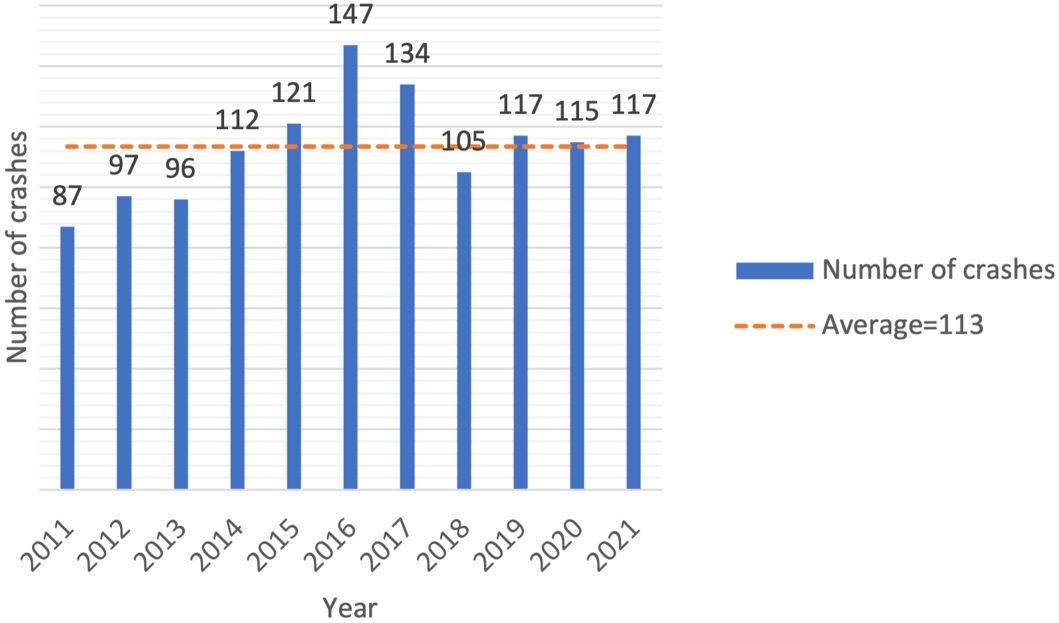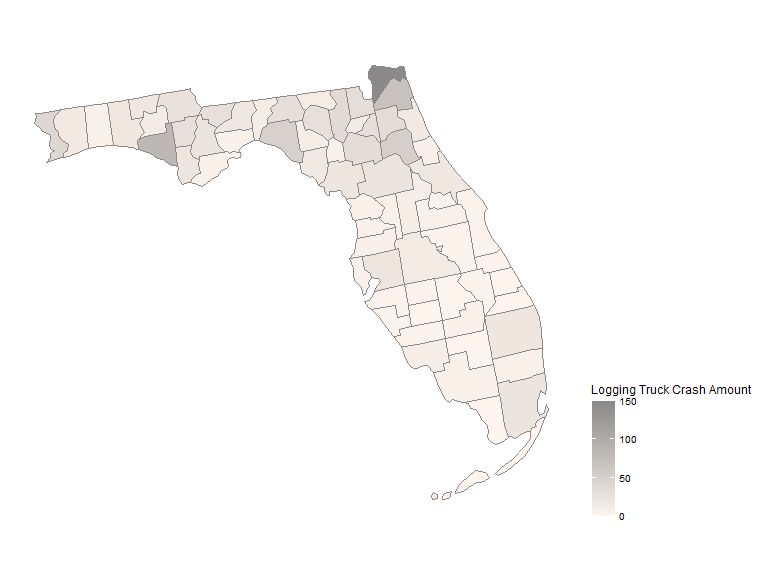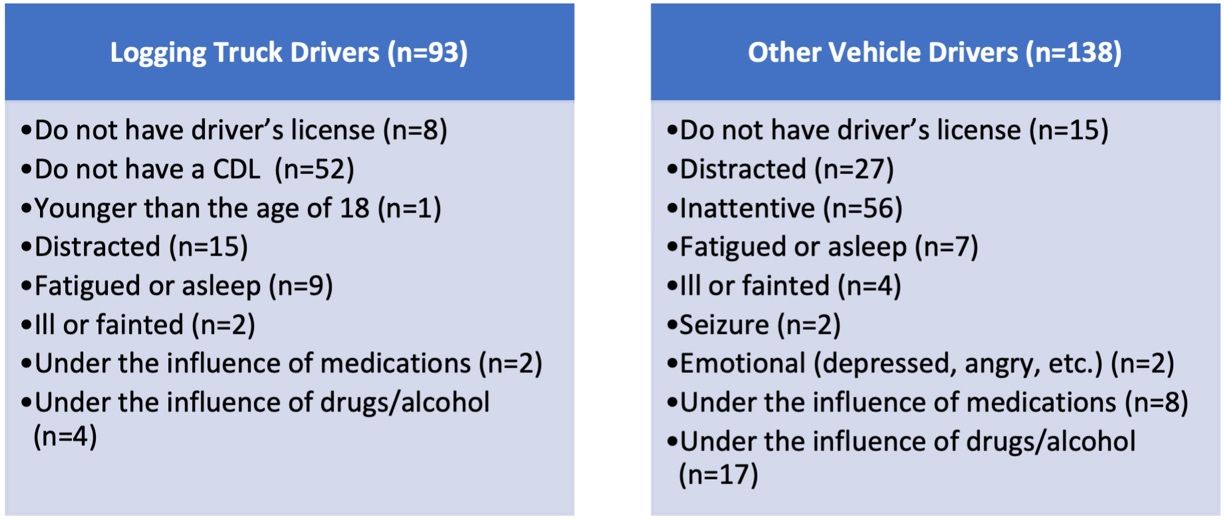Roadway Safety: Logging Truck-Related Crashes in Florida
The forestry industry contributes $25 billion to the Floridian economy and employs over 124,000 workers (Florida Forestry 2018). The transportation of logs is an important part of the wood processing industry in the United States, specifically in the southeastern United States (Cole et al. 2019). The harvesting of logs is done in remote locations and the harvest must be transported to processing centers. The forests cover about half of Florida’s land area.
Logging trucks are large trucks with trailers that are used to transport logs from harvesting sites to processing facilities. The large size and weight of these vehicles can result in hazards on public roadways. A crash involving a logging truck can be expected to increase severity of injury and damage.
The size and weight of logging trucks can present significant challenges on public roadways. Logging trucks may have limited maneuverability and longer stopping distances. Due to the logging trucks' larger size, drivers of the other vehicles can have their vision obstructed when driving near logging trucks. Logging truck drivers must hold a commercial driver’s license (CDL) to legally drive the logging vehicle. To possess a CDL, drivers must be at least 18 years old. If drivers are under the age of 21, they are restricted to intrastate driving only (FLHSMV 2023). Even though loggers take extra measures to make sure logs are secure on the trailer before leaving the logging site, improperly secured logs can create additional safety risks. Additionally, driving large trucks may be difficult during inclement weather, and the road conditions may not properly support such large and heavy trucks.
The following is an example of a crash involving a logging truck. This crash demonstrates the hazards these heavy trucks can present. Safety precautions for both the logging truck driver and drivers of other vehicles can help to prevent such accidents. “A Florida woman was killed this week when she crashed with a truck hauling logs. State troopers said the woman driving an SUV ‘failed to maintain a safe distance’ and hit the back of the log truck’s trailer. The impact reportedly knocked logs off the trailer and into the woman’s SUV” (NBC News 2023).
Florida Statutes require that the truck and cargo must not exceed a length of 75 feet. The cargo must not exceed a length of 48 feet. These large vehicles can weigh up to 80,000 pounds. If the logs extend more than 4 feet beyond the rear of the body or bed of the vehicle, the vehicle must have one amber strobe-type lamp equipped with a multidirectional lens. This lamp must be mounted so it is visible from the rear and both sides of the projecting load. The projecting load must also be marked with a red flag (Florida Statutes 316.228). Additional information on rules and regulations can be found in A Logger’s Guide to Trucking Requirements (https://www.flhsmv.gov/pdf/cve/loggermanual.pdf).
This report summarizes logging truck-related crashes in Florida. The intended audience for this publication is the general public. Crash data were obtained for eleven years (2011–2021) from the Florida Department of Highway Safety and Motor Vehicles (FLHSMV). Logging truck-related crashes were selected from the dataset.
This publication is excerpted from a 2023 ASABE Annual International Meeting conference paper, “Characterizing Logging Truck-Related Crashes in Florida: 2011–2021” by Madison Moore, Serap Gorucu, and Nikolay Bliznyuk (Moore et al. 2023).
Crash Characteristics
There were 1,253 crashes related to logging trucks in the years 2011–2021 (Figure 1). These crashes involved 2,216 vehicles and 2,535 individuals. There were 1,251 logging trucks involved in crashes; the remaining 965 were other vehicles. In total, there were 1,242 occupants in logging trucks and 1,293 occupants in other vehicles.

Credit: Serap Gorucu, UF/IFAS
Of the 1,253 crashes, almost 73% of the crashes involved two or more motor vehicles (Table 1). There were 891 crashes (71%) that occurred in rural areas. Almost 64% of the crashes involved collisions with other motor vehicles (Table 1). About half of the single-vehicle logging truck incidents were rollovers.
Table 1. Summary statistics for crash level variables.
Figure 2 summarizes the number of logging truck-related crashes by county. The counties with the largest number of crashes were Nassau (n=150, 12%), Bay (n=83, 7%), Duval (n=69, 6%), Putnam (n=53, 5%), Taylor (n=49, 4%), and Escambia (n=42, 3%).

Credit: Madison Moore, UF/IFAS
Vehicles
Logging truck-related crashes involved 2,216 vehicles during the 11 years of the study. Other vehicles involved in crashes with logging trucks included passenger cars, pickup trucks, and sport utility trucks, among others (Table 2). The vehicles had disabling and functional damage in 61% of the crashes. Vehicle defects contributed to the crashes (81 vehicles with defects). Thirty-one vehicles in logging truck-related crashes had tire and wheel defects, and 22 logging trucks had brake system defects.
Table 2. Vehicle level variables.
Driver Violations
During the period examined by this study, logging truck-related crashes involved 1,202 drivers of logging trucks and 1,293 drivers of other vehicles. There were traffic violations cited to both the drivers of the logging trucks (n=93) and the drivers of the other vehicles (n=138) involved in these crashes (Figure 3).
Even though speeding was not reported as contributing to driver actions, we found that 20 logging truck drivers and 29 other vehicle drivers were operating their vehicles at 10 mph or more over the posted speed limits.

Credit: Serap Gorucu, UF/IFAS
Injuries
A total of 535 individuals were injured in these crashes (21% of all total individuals). Sixty-six percent of the individuals injured in these crashes were occupants of other vehicles. Ninety-three people suffered incapacitating injuries which required transport to a medical facility and hospitalization. Thirty-three people suffered fatal injuries. The remaining 409 suffered non-incapacitating (i.e., visible, non-disabling injuries) or possible injuries (i.e., no visible signs of injury but complaints of pain or loss of consciousness). Drivers of the other vehicles were at significantly higher risk of being injured when compared to the occupants of the logging trucks (27% vs. 14.5%; Figure 4).

Credit: Serap Gorucu, UF/IFAS
Key Findings
This publication reports logging truck vehicle crashes in the state of Florida in the years 2011–2021. A few highlights from this report are listed below.
- Logging trucks pose safety dangers to the occupants of the other vehicles involved in these crashes. 66% of the people injured in the logging truck-related crashes were occupants of other vehicles.
- Most of these crashes occur in the northern part of the state where there is more logging activity.
Notes and Recommendations for Safety
- Driver’s license: Driving without a driver’s license or the proper class of driver’s license (specifically for drivers of the logging trucks) was the most common violation. As stated in Florida Statute 322.03, it is against the law to use a motor vehicle without a license (Florida Statutes 2023). A driver’s license shows that the individual understands the traffic rules and regulations and has the skills to operate a vehicle safely.
- Following distance: Large trucks require more space for stopping so it is recommended to keep a safe following distance. According to the Florida Commercial Driver License Manual, here is the suggested space (in seconds) you should keep in front of you based on your vehicle length and speed (FLHSMV 2022b):
- At least one second for every 10 feet of vehicle length between you and the leading vehicle at speeds under 40 mph.
- Add an additional second for safety at speeds more than 40 mph.
- Distracted driving: Completing a secondary task while driving diverts attention away from the task of driving. Many violations by the driver of the other vehicle involve forms of distracted and fatigued driving. Even a split-second loss of focus can lead to an increased risk of a crash. According to the National Highway Traffic Safety Administration, 3,142 people died in motor vehicle crashes involving distracted drivers in 2020 (NHTSA 2023).
- Drug/medications/alcohol-impaired driving: The influence of alcohol and drugs can lead to various impairments for drivers such as slowed reaction times, impaired short-term memory functions, reduced hand-eye coordination, diminished concentration, and difficulties in accurately perceiving time and distance (FLHSMV 2023). These impairments significantly elevate the risk of accidents and compromise overall road safety. It is essential for individuals to recognize the severe consequences of driving while under influence and to prioritize the safety of themselves and others on the road by making responsible choices (NHTSA 2023).
- Fatigued driving: Fatigue, lack of sleep, and drowsiness can result in crashes when driving. According to the CDC, being awake for 17 consecutive hours and 24 consecutive hours is like having a blood alcohol level of 0.05% and 0.10%, respectively. It is recommended to get seven to eight hours of sleep daily. Additionally, alcohol consumption combined with lack of sleep worsens the impairment (CDC-NIOSH 2020; NHTSA 2023).
The Florida Forestry Association’s Master Logger Program provides education and certification (https://www.flforestry.org/programs/master-logger/). Safe driving is a part of the training. The findings from this study can be included in the program to stress the importance of safe driving for logging truck drivers.
Other Useful Safety Resources
A Logger’s Guide to Trucking Requirements by the Florida Highway Patrol Office of Commercial Vehicle Enforcement
Tips for Driving Safely Around Large Trucks or Buses by the U.S. Department of Transportation, Federal Motor Carrier Safety Administration
How to Safely Share the Road with Semi-Trucks by the Roadway Safety Foundation
Tips for Truck and Bus Drivers by the U.S. Department of Transportation, Federal Motor Carrier Safety Administration
Trucking Industry by the Occupational Safety and Health Administration
References
CDC-NIOSH. 2020. "NIOSH Training for Nurses on Shift Work and Long Work Hours." https://www.cdc.gov/niosh/work-hour-training-for-nurses/longhours/mod3/08.html
Cole, N. B., S. M. Barrett, M. C. Bolding, and W. M. Aust. 2019. “An Analysis of Fatal Log Truck Crashes in the United States from 2011 through 2015.” International Journal of Forest Engineering 30(2): 121–131. https://doi.org/10.1080/14942119.2018.1564964
FLHSMV. 2022a. “Commercial Driver's License.” Florida Department of Highway Safety and Motor Vehicles. https://www.flhsmv.gov/driver-licenses-id-cards/commercial-motor-vehicle-drivers/commercial-driver-license/#:~:text=All%20applicants%20for%20a%20Commercial,restricted%20to%20intrastate%20operation%20only
FLHSMV. 2022b. Florida Commercial Driver License Manual. Florida Department of Highway Safety and Motor Vehicles. https://www.flhsmv.gov/pdf/handbooks/englishcdlhandbook.pdf
FLHSMV. 2023. “Impaired Driving.” Florida Department of Highway Safety and Motor Vehicles. https://www.flhsmv.gov/safety-center/driving-safety/impaired-driving/
Florida Forestry Association. 2018. “Florida Forestry.” Retrieved April 21, 2023. https://www.flforestry.org/about-us/fl-forests-facts/#:~:text=Forests%20cover%20about%20half%20of,timberlands%20lying%20north%20of%20Orlando
Florida Statutes. 2023. “322.03. Drivers must be licensed, penalties.” http://www.leg.state.fl.us/statutes/index.cfm?App_mode=Display_Statute&URL=0300-0399/0322/Sections/0322.03.html
Moore, M., S. Gorucu, and N. Bliznyuk. 2023. “Characterizing Logging Truck-Related Crashes in Florida: 2010–2021.” In 2023 ASABE Annual International Meeting. 1. American Society of Agricultural and Biological Engineers.
NBC News. 2023. “Florida woman killed in crash with truck hauling logs.” Retrieved July 27, 2023. https://mynbc15.com/news/nation-world/florida-woman-killed-in-crash-with-truck-hauling-logs-jacksonville-fernandina-beach-yulee-road-driver-safety-maintaining-safe-distance
NHTSA. 2023. “Risky Driving.” National Highway Traffic Safety Administration. https://www.nhtsa.gov/risky-driving




